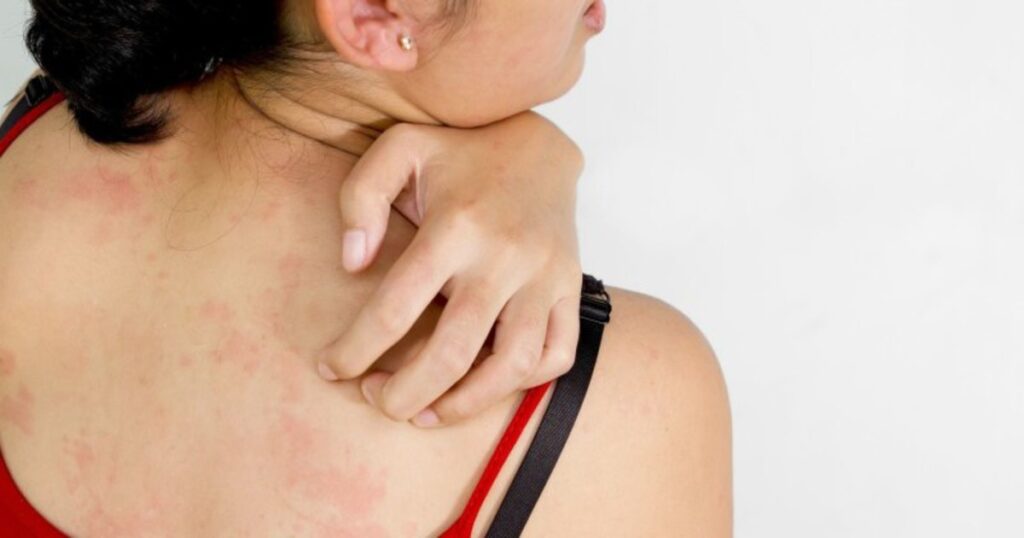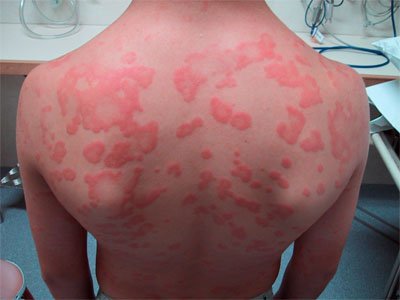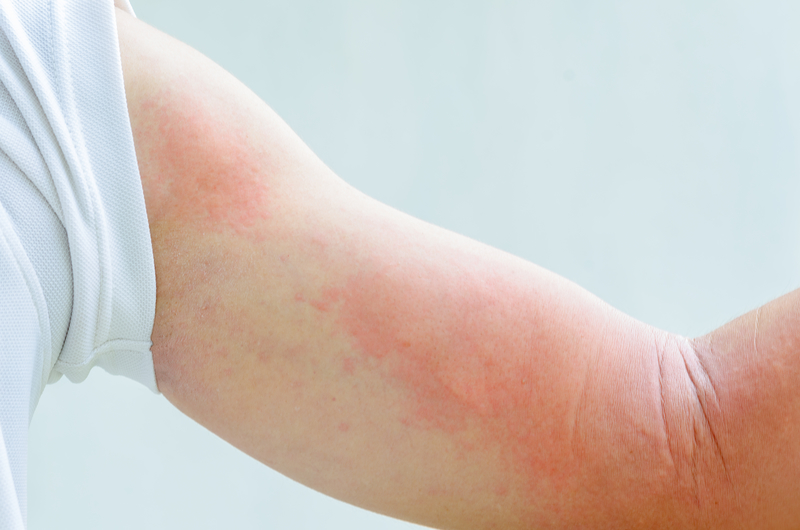Urticaria, which is commonly called hives, means rash on your body. It presents as reddish wheals or welt bumps that appear on your skin. Urticaria is also known as Nettle rash. This condition mainly consists of wheal spots or patches of raised red and white skin, each of which clears away in a few hours only to be replaced by fresh wheals. The welts may vary in size and fade & occur repeatedly as the reaction course sets in. It sometimes occurs together with swelling of various parts of the body, particularly the face, hands, and feet, resulting in angioedema.
Angioedema is another skin condition. It is a deeper swelling affecting the tongue, mouth, throat, and upper airway. Urticaria along with angioedema may occur at a different time or together in the same person. It may occur in two forms. A wheal which is skin-colored or pale skin swelling with erythema or redness surrounding it that lasts anything between a few minutes to 24 hours. It usually causes itching and burning pain in the skin. Angioedema is the deeper swelling within the skin and the mucous membranes. When hives last for more than 6 weeks, it is considered chronic. And, when hives occur without any cause, it is considered idiopathic.
Hives can be quite uncomfortable and interfering with sleep and normal day to day activities. Sufferers often don’t say anything at all, and they prefer scratching which may lead to worsening of the situation. So, you might be wondering what causes the rash, aren’t you? Most of the time, you cannot pinpoint the cause of the rash. Whatever is the cause, your immune system senses hostile invaders and kicks into an overdrive mechanism. Tiny build vessels begin to leak protein-rich fluid and this causes the build-up of the fluid under the skin leading to red patches, wheals, and welts which result in excessive irritation of skin along with itching. The first line of defense is the skin. There are two types of urticaria:
- Acute urticaria which lasts for the duration of up to or less than six weeks.
- Chronic urticaria which lasts more than six weeks with an episodic flare-up of wheals.
An outbreak that looks alarming the first thing in the morning may vanish by noon only to be back in full force later in the day. Because hives fluctuate so intensely and so fast, it is helpful to bring along the photograph of the prevailing hives when visiting a dermatologist for further evaluation. Hives appear when histamine and other compounds, which the mast cells release, are is found in the skin. Histamine results in the leakage of the fluid from the local blood vessel, thereby leading to the swelling of the skin. Hives are very common but not contagious.
Despite the reputation of hives being an allergic reaction, there is an obvious connection of provoking substrate.
- Dermatographism, which signifies skin writing, is the common cause of physical urticaria. This is an exaggerated form of what happens to someone when the skin is rubbed or scratched and a red welt appears at the site of the scratch. In dermatographism, you may experience raised itchy welts of red skin with adjacent flares, particularly when you scratch the skin or at the body areas where belts or other clothing rubs against the skin.
- Cholinergic hives: Another form of hives that produces hundreds of welts and itch after 15 minutes of physical exertion is cholinergic hives. This kind of cholinergic hives is observed mostly in young people.
We treat patients from the USA, UK, Canada, Australia, UAE & 180 more countries. Get an expert opinion on your ailment, click here to ask Dr. Shah’s team directly.
Theories of Urticaria:
Researchers have come up with many theories that may cause urticaria.
Autoimmune theory: In some patients with chronic spontaneous urticaria, certain factors in the blood can trigger the release of histamine from the mast cells can lead of process known as autoimmunity which is the theory behind urticaria.
Triggering Factors/Conditions of Urticaria:
Although hives are associated with allergic reactions, certain factors and conditions can trigger urticaria. They are listed below.
- Stress
- Medication: If you suspect any medication is causing the urticaria as a side-effect, inform your doctor about the same.
- Insect bites
- Sunlight
- Eating shellfish, nuts, apples, and peaches
- Cold temperature: Temperature changes may cause the hives to trigger, thereby resulting in the development of wheals on the skin. It may cause dryness of the skin which may lead to itching.
- Cosmetics
- Harsh soaps or detergents
- Infection
- Underlying condition: Any kind of allergic reaction or underlying allergy can cause hives. In some cases, the hives may be due to thyroid disorder which is an autoimmune condition that needs to be treated.
- Pet allergies
- Hay fever
- Autoimmune disorders, such as diabetes type 1, lupus, and rheumatoid arthritis.
Identifying what’s triggering your rash is essential, as it can help you avoid the allergens and prevent the occurrence of the episode of urticaria.
Signs of Severe Allergic Condition
Here are some symptoms that indicate a severe form of urticaria which may need emergency and care.
- Dizziness
- Swelling of the face or throat
- Difficulty in breathing
Signs & Symptoms of Urticaria:
Here are some common symptoms of urticaria.
- Rash which is raised swollen like hives and have reddish velvety bumps
- Itching occurring in the affected area of the skin rash
- The selling of throat eyelids and lips (Angioedema)
- Stress and heat exercise may aggravate the discomforting symptoms of urticaria.
Diagnosis of Urticaria:
A confirmed diagnosis can be a feature of the skin condition and the symptoms. Also, a professional doctor will recommend the blood test in the form of an allergy test to confirm the same.
Homeopathic Management for Urticaria:
It is essential to go for a natural homeopathic treatment which works at the internal level and treat the allergy. Homeopathic treatment for urticaria makes the symptoms to subside and work at the root cause of the condition. One medicine is given mainly to take care of the constitution and the other medicine is given to take care of the symptoms, thereby achieving recovery from the condition at the internal level rather than just superficially. Complementing treatment with symptomatic relief will give a great success rate in homeopathic management.
So, if any time you happen to suffer from the discomforting urticaria, opt for homeopathic treatment for urticaria without a second thought. Obtain relief from hives and improve your quality of life with homeopathy.




